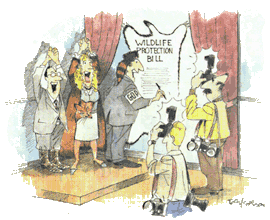Political Animals The Fight to Save the ESA

Wildlife protection is headed for a showdown, but it may not come in the current Congress. The main players are Senator Dirk Kempthorne (R-ID) and Representative George Miller (D-CA); both have sponsored bills which, if passed, would dramatically change the face of the Endangered Species Act (ESA). Senate bill 1180, introduced by Kempthorne in 1997, weakens the ESA by adding new bureaucracy, and offering a 15-month window in which destructive actions, such as clearcutting, could continue after a species has been listed. It also gives the government considerable leeway in preparing recovery plans.
House bill 2351, introduced by Miller, also in 1997, strengthens the act by allowing more public participation; requiring more federal research on candidate species; providing tax incentives for landowners who voluntarily agree to implement beneficial measures; and establishing binding deadlines for recovery plans.
Unfortunately, while the Kempthorne bill passed through the Senate’s Committee on Environment and Public Works and was placed on the calendar in less than a month and a half, the Miller bill is not likely to get out of the House Committee on Resources, chaired by the notoriously anti-wildlife Don Young (R-AK).
Kim Delfino, staff attorney for the U.S. Public Interest Research Group (PIRG), feels that “if anything, we’ll be fighting a defensive battle and building support for [reauthorization in] the next Congress.” In the meantime, lobbyists will have their hands full protesting the wave of anti-environmental riders that, Delfino predicts, will likely come in the form of piecemeal attacks on particular endangered species, such as grizzlies, wolves and salmon. Last year, 22 of 40 such riders passed Congress.
CONTACT
Public Interest Research Group
215 Pennsylvania Avenue SE
Washington, DC 20003
Tel. (202) 546-9707
URL: http://www.pirg.org/

